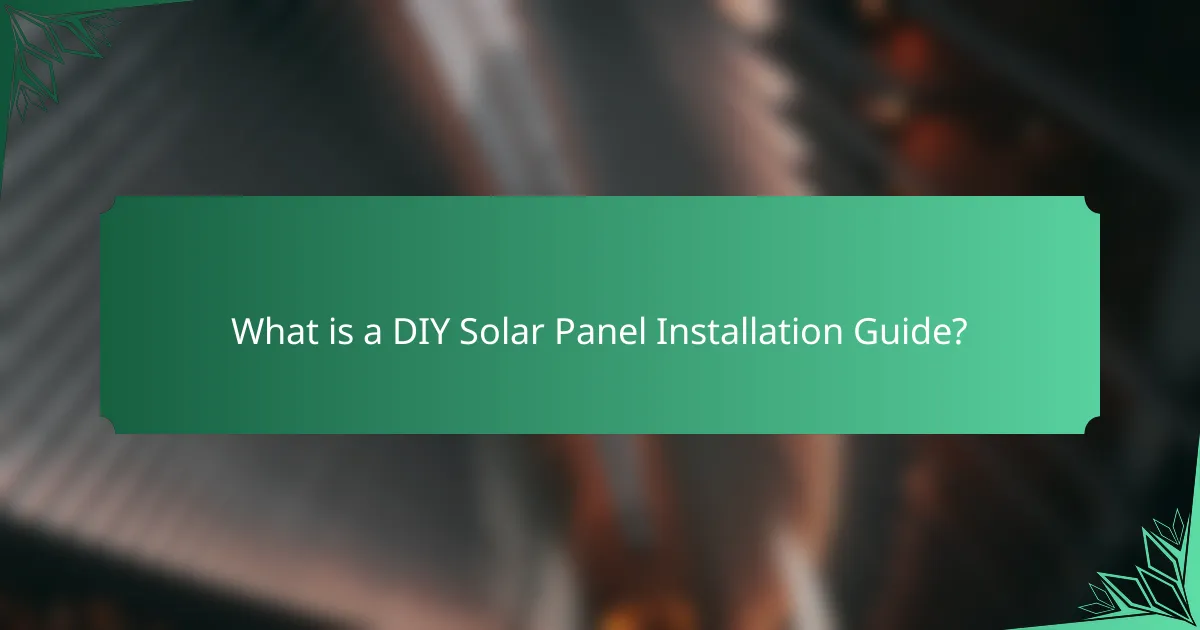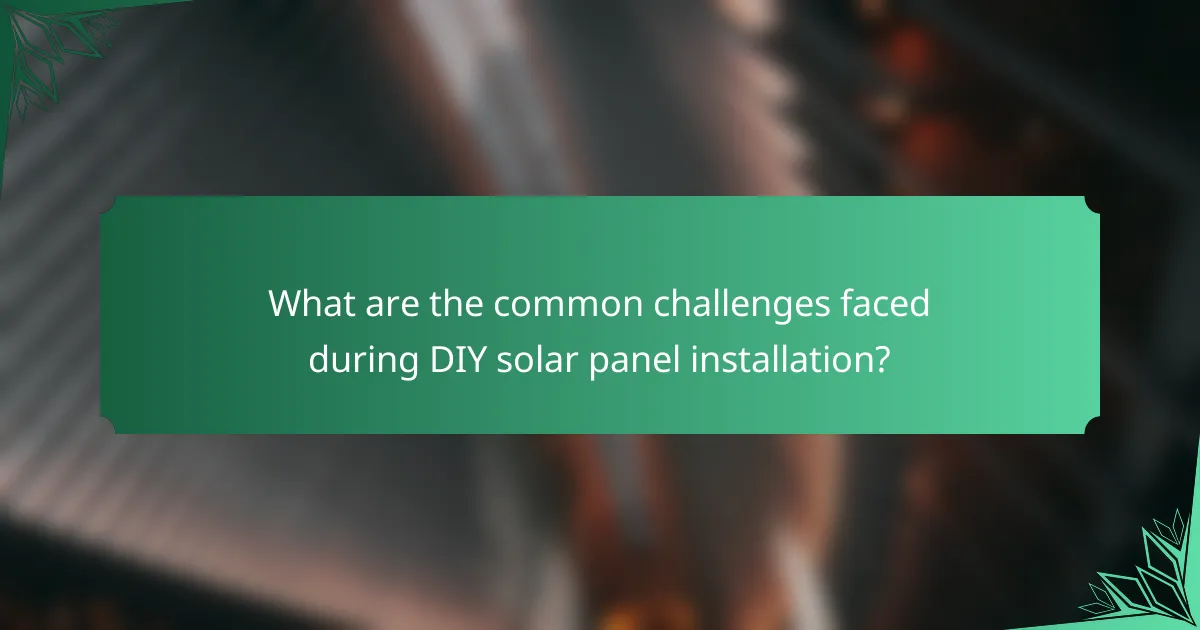
What is a DIY Solar Panel Installation Guide?
A DIY Solar Panel Installation Guide is a step-by-step manual for individuals to install solar panels on their own. This guide typically includes information on necessary tools, safety precautions, and installation techniques. It aims to empower homeowners to harness solar energy efficiently. The guide often covers planning, mounting, wiring, and connecting to the electrical system. It may also provide estimates of installation duration and costs involved. Many resources are available online, including videos and articles, to assist in the process. Following a DIY guide can lead to significant savings on installation fees.
How can a DIY Solar Panel Installation Guide benefit homeowners?
A DIY Solar Panel Installation Guide can significantly benefit homeowners by reducing installation costs. Homeowners can save thousands of dollars by avoiding professional installation fees. This guide provides step-by-step instructions, making the process accessible. It empowers homeowners with knowledge about solar technology. Understanding the installation process leads to informed decisions about energy usage. Additionally, homeowners can customize the system to fit their specific needs. A DIY approach also promotes self-sufficiency and sustainability. Studies show that solar energy can lower electricity bills by up to 70%.
What are the key steps outlined in a DIY Solar Panel Installation Guide?
The key steps outlined in a DIY Solar Panel Installation Guide include site assessment, obtaining permits, and selecting equipment. First, conduct a site assessment to evaluate sunlight exposure and roof condition. Next, obtain any necessary permits from local authorities. After that, select the appropriate solar panels and inverter based on energy needs. Then, prepare the installation area by ensuring a clean and stable surface. Following preparation, mount the solar panels securely to the roof or ground. Connect the inverter and wiring according to the manufacturer’s instructions. Finally, conduct a system check to ensure everything operates correctly. These steps are essential for a successful DIY solar panel installation.
How does following a guide simplify the installation process?
Following a guide simplifies the installation process by providing clear, step-by-step instructions. These instructions help users understand each phase of the installation. They reduce confusion and minimize errors during setup. Guides often include visuals, such as diagrams or photos, which enhance comprehension. They also list necessary tools and materials, ensuring users are prepared. This preparation prevents delays and promotes efficiency. Additionally, guides may highlight common pitfalls to avoid, further streamlining the process. By following a structured approach, users can complete installations more confidently and successfully.
What tools are needed for DIY solar panel installation?
To install solar panels DIY, specific tools are required. Essential tools include a drill, screwdriver, and wrenches. A voltage meter is needed for electrical checks. Additionally, a level ensures proper alignment of panels. Safety gear like gloves and goggles is crucial for protection. A ladder is necessary for roof access. A solar panel mounting system is also required for secure installation. These tools facilitate a successful and safe solar panel installation process.
Which essential tools should every DIY solar installer have?
Every DIY solar installer should have a multimeter, wire strippers, and a drill. A multimeter is essential for measuring voltage and ensuring proper electrical connections. Wire strippers are necessary for preparing wires for connections. A drill is needed for mounting solar panels securely. Additionally, a level ensures panels are installed at the correct angle for optimal sunlight exposure. Safety gear, including gloves and goggles, is crucial to protect against electrical hazards. Finally, a torque wrench is important for tightening bolts to the manufacturer’s specifications. These tools are commonly recommended in DIY solar installation guides.
How do specialized tools enhance the installation experience?
Specialized tools enhance the installation experience by providing precision and efficiency. These tools are designed specifically for tasks such as measuring, cutting, and securing solar panels. For example, a solar panel installation tool can ensure accurate measurements, reducing errors. This leads to a smoother installation process. Additionally, specialized tools often include features that simplify complex tasks. A torque wrench, for instance, helps achieve the correct tightness for mounting hardware. This prevents damage and enhances durability. According to industry standards, using the right tools can reduce installation time by up to 30%. Overall, specialized tools streamline the installation, making it more effective and user-friendly.
What is the typical duration for a DIY solar panel installation?
The typical duration for a DIY solar panel installation is between one to three days. This timeframe depends on several factors, including the size of the system and the complexity of the installation. A small system may take just one day, while larger systems might require up to three days. Preparation and planning can also influence the duration. Tasks such as gathering tools and materials, as well as obtaining necessary permits, can extend the timeline. Additionally, experience level plays a role; beginners may need more time compared to those with prior experience.
What factors influence the installation duration?
Installation duration is influenced by several key factors. The complexity of the solar panel system significantly impacts time. Larger systems typically require more time due to additional components. Weather conditions also play a crucial role; rain or high winds can delay installation. The experience level of the installer affects efficiency; seasoned professionals work faster than novices. Site preparation is another factor; a clear, accessible area speeds up the process. Local regulations and permitting can introduce delays; obtaining necessary approvals takes time. Lastly, the availability of tools and equipment can influence how quickly the installation is completed. Each of these factors contributes to the overall time required for solar panel installation.
How can planning and preparation reduce installation time?
Planning and preparation can significantly reduce installation time for DIY solar panel projects. Effective planning involves assessing the site and gathering all necessary tools and materials beforehand. This minimizes delays caused by searching for items during installation.
Preparation includes creating a detailed installation schedule. A well-defined timeline allows for efficient task allocation and reduces downtime. Additionally, pre-installation checks on equipment ensure everything functions correctly, preventing interruptions.
Research indicates that projects with thorough planning can cut installation time by up to 30%. This efficiency is crucial for maintaining project momentum and achieving timely completion.

What are the common challenges faced during DIY solar panel installation?
Common challenges faced during DIY solar panel installation include safety concerns, technical knowledge gaps, and equipment compatibility issues. Safety concerns arise from working at heights and handling electrical components. Many DIY installers lack sufficient technical knowledge about solar systems and electrical wiring. Equipment compatibility issues can occur when solar panels do not match inverters or mounting systems. Additionally, local regulations and permits may complicate the installation process. Weather conditions can also hinder installation timelines. Finally, potential damage to the roof or property during installation poses a risk.
How can you troubleshoot issues during installation?
To troubleshoot issues during installation, first check all connections. Ensure that wiring is secure and correctly configured. Inspect the solar panels for any visible damage. Verify that the inverter is functioning properly. Test the system’s voltage output to confirm it meets specifications. Review the installation manual for specific troubleshooting steps. Consult online forums or support groups for additional guidance. Document any persistent issues for further analysis.
What are the most frequent problems encountered by DIY installers?
The most frequent problems encountered by DIY solar panel installers include improper measurements and inadequate tools. Many installers miscalculate the space required for panels, leading to installation issues. Additionally, lack of proper tools can hinder the installation process. Electrical connections are often a challenge, with mistakes leading to system failures. Weather conditions can also impact installation, causing delays and complications. Safety concerns arise when installers lack proper protective equipment. Finally, obtaining necessary permits can be a bureaucratic hurdle for DIY installers. These issues are commonly reported in DIY solar panel installation forums and guides.
How can proper research mitigate installation challenges?
Proper research can significantly mitigate installation challenges in DIY solar panel projects. It allows individuals to understand local regulations and requirements. Knowledge of specific installation techniques can prevent common mistakes. Research helps in selecting the right tools and materials suited for the project. It also provides insights into optimal panel placement for maximum efficiency. Furthermore, understanding potential obstacles, like shading or structural issues, can be addressed beforehand. A study by the National Renewable Energy Laboratory highlights that informed homeowners experience fewer installation errors. This proactive approach ultimately leads to a smoother installation process and better performance of the solar system.
What safety precautions should be taken during installation?
Safety precautions during installation include wearing appropriate personal protective equipment (PPE). This should consist of safety goggles, gloves, and hard hats. Ensure the work area is clear of obstacles and hazards. Use insulated tools to prevent electrical shock. Secure ladders and scaffolding properly to avoid falls. Verify that all electrical components are de-energized before beginning work. Follow local building codes and regulations to ensure compliance. These measures help prevent accidents and injuries during solar panel installation.
What personal protective equipment is recommended for DIY solar panel installation?
For DIY solar panel installation, recommended personal protective equipment includes safety glasses, gloves, and a hard hat. Safety glasses protect the eyes from debris and harmful UV rays. Gloves provide hand protection from sharp edges and electrical components. A hard hat safeguards against falling objects, especially when working on rooftops. Additionally, non-slip footwear is essential for stability on ladders and rooftops. Wearing a high-visibility vest can enhance safety when working near roadways or in busy areas. These items are crucial for minimizing injury risks during the installation process.
How can you ensure electrical safety while installing solar panels?
To ensure electrical safety while installing solar panels, always disconnect the power supply before starting. This prevents electrical shocks during the installation process. Use insulated tools to minimize the risk of accidental contact with live wires. Wear personal protective equipment, including gloves and safety glasses, to protect against electrical hazards. Ensure that all wiring is properly grounded to prevent electrical surges. Follow the manufacturer’s instructions for installation to avoid improper connections. Verify that all components are certified and meet safety standards. Regularly inspect the system for any signs of wear or damage after installation. These practices significantly reduce the risk of electrical accidents.

What are the benefits of installing solar panels yourself?
The benefits of installing solar panels yourself include cost savings, increased control, and a sense of accomplishment. DIY installation eliminates labor costs, which can account for 10-20% of total solar panel expenses. Homeowners gain greater control over the installation process, ensuring it meets their specific needs. Completing the project independently can provide a strong sense of achievement. Additionally, self-installation allows for a personalized approach to solar panel placement, optimizing energy efficiency. Research shows that DIY solar installations can reduce initial investment costs significantly, making renewable energy more accessible.
How does DIY solar panel installation save money?
DIY solar panel installation saves money by eliminating labor costs associated with professional installation. Homeowners can save up to 50% on installation expenses by doing it themselves. Additionally, they can take advantage of tax credits and incentives, which often apply to self-installed systems. According to the U.S. Department of Energy, homeowners can receive a federal tax credit of 26% for solar panel systems installed before the end of 2022. Furthermore, DIY installation allows homeowners to choose cost-effective materials and components. This flexibility can lead to significant savings compared to pre-packaged systems. By reducing overall installation costs, DIY solar panel projects can provide a faster return on investment.
What financial incentives are available for DIY solar projects?
Financial incentives for DIY solar projects include federal tax credits, state rebates, and local incentives. The federal solar tax credit allows homeowners to deduct a percentage of the cost of installing solar systems from their federal taxes. This percentage is currently set at 26% for systems installed through 2022, decreasing to 22% in 2023. Many states also offer rebates for solar installations, which can significantly reduce upfront costs. Additionally, some local governments provide incentives such as property tax exemptions or solar renewable energy certificates. These incentives can vary widely by location. It is essential for DIY solar project owners to research specific programs in their area for the most accurate information.
How does self-installation affect long-term maintenance costs?
Self-installation generally reduces long-term maintenance costs for solar panels. When homeowners install their own systems, they save on labor expenses associated with professional installation. This initial savings can lead to a lower overall investment in the solar system.
Additionally, self-installed systems often result in better understanding and familiarity with the equipment. This knowledge enables homeowners to perform routine maintenance and minor repairs themselves. By addressing issues quickly, they can avoid costly service calls from professionals.
Research indicates that homeowners who actively engage in the maintenance of their solar systems can extend the lifespan and efficiency of the panels. According to the National Renewable Energy Laboratory, regular maintenance can enhance energy output by up to 20%.
In summary, self-installation typically leads to reduced long-term maintenance costs through savings on labor, increased knowledge for DIY maintenance, and improved system efficiency.
What skills are beneficial for a successful DIY solar panel installation?
Beneficial skills for a successful DIY solar panel installation include electrical knowledge, basic carpentry skills, and problem-solving abilities. Electrical knowledge helps in safely connecting solar panels to the home’s power system. Basic carpentry skills assist in constructing and securing mounting systems for the panels. Problem-solving abilities enable installers to troubleshoot issues that may arise during the installation process. Additionally, familiarity with tools such as drills, wrenches, and voltage testers is essential. Understanding local building codes and regulations also contributes to a compliant installation. These skills collectively ensure a safer and more efficient solar panel installation.
How can basic electrical knowledge improve installation outcomes?
Basic electrical knowledge can significantly enhance installation outcomes for solar panels. Understanding electrical principles ensures safe and efficient connections. Knowledge of voltage, current, and resistance helps in selecting appropriate wiring. Proper grounding techniques reduce the risk of electrical hazards. Familiarity with circuit diagrams aids in accurate installation and troubleshooting. This knowledge minimizes errors that could lead to costly repairs. According to the National Renewable Energy Laboratory, well-trained installers can improve system performance by up to 20%. Thus, basic electrical understanding directly correlates with successful solar panel installations.
What resources can help develop necessary installation skills?
Online courses can help develop necessary installation skills. Websites like Coursera and Udemy offer courses on solar panel installation. These courses cover essential topics such as system design and electrical safety. Additionally, YouTube has numerous tutorial videos demonstrating installation techniques. Instructional videos can provide visual guidance for complex tasks. Local community colleges may also offer hands-on workshops. These workshops can provide practical experience with real equipment. Industry associations, like the Solar Energy Industries Association, offer resources and training materials. Access to these resources can significantly enhance installation skills.
What tips can ensure a successful DIY solar panel installation?
To ensure a successful DIY solar panel installation, start by thoroughly researching local regulations and permits. Understanding these requirements will prevent legal issues. Next, choose a suitable location for the panels, ensuring maximum sunlight exposure. This typically means installing them on a south-facing roof.
Gather all necessary tools and equipment before starting the installation. Essential tools include a drill, level, and wiring tools. Follow the manufacturer’s instructions carefully during installation. This ensures proper setup and optimal performance.
Consider enlisting a friend for assistance. This can make the installation process smoother and safer. After installation, conduct a thorough inspection to ensure everything is secure and functioning correctly. Regular maintenance checks will help maintain efficiency over time.
How can you effectively plan your solar panel layout?
To effectively plan your solar panel layout, start by assessing your roof’s orientation and tilt. South-facing roofs typically receive the most sunlight in the Northern Hemisphere. Next, measure the available roof space to determine how many panels can fit. Each solar panel requires about 17.5 square feet of space. Consider potential shading from trees or nearby structures, as this can significantly reduce efficiency. Use solar design software to simulate the layout and optimize panel placement. Additionally, ensure that the layout allows for proper airflow and maintenance access. Finally, check local regulations and building codes to ensure compliance.
What are the best practices for securing solar panels to a roof?
The best practices for securing solar panels to a roof include using appropriate mounting systems. These systems should be compatible with the roof type. Properly installed rail systems provide stability. Use corrosion-resistant hardware to prevent deterioration. Ensure the mounting brackets are anchored to the rafters or trusses for maximum support. Seal any penetrations made during installation to prevent leaks. Regularly inspect the installation for signs of wear or damage. Following these practices enhances the longevity and effectiveness of the solar panel system.
The main entity of the article is the DIY Solar Panel Installation Guide, which provides a comprehensive manual for individuals looking to install solar panels independently. The article outlines essential tools required for the installation process, key steps involved, estimated installation duration, and potential challenges faced by DIY installers. It emphasizes the benefits of self-installation, including cost savings, increased control, and enhanced understanding of solar technology. Additionally, the article highlights safety precautions and best practices to ensure a successful solar panel installation.